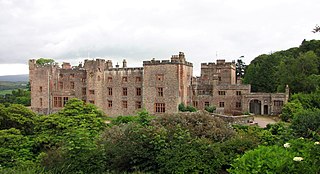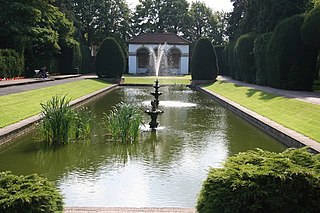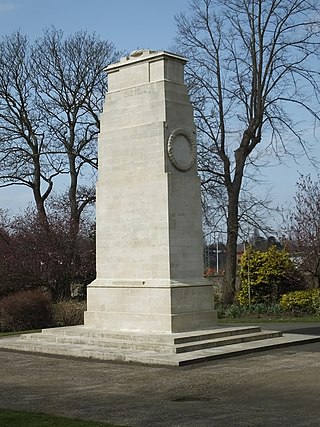
Muncaster Castle is a privately owned castle overlooking the River Esk, about a mile east of the west-coastal town of Ravenglass in Cumbria, England. It is recorded in the National Heritage List for England as a designated Grade I listed building.

Rochdale Cenotaph is a First World War memorial on the Esplanade in Rochdale, Greater Manchester, in the north west of England. Designed by Sir Edwin Lutyens, it is one of seven memorials in England based on his Cenotaph in London and one of his more ambitious designs. The memorial was unveiled in 1922 and consists of a raised platform bearing Lutyens' characteristic Stone of Remembrance next to a 10-metre (33 ft) pylon topped by an effigy of a recumbent soldier. A set of painted stone flags surrounds the pylon.

The South African War Memorial is a First World War memorial in Richmond Cemetery in the London Borough of Richmond upon Thames. Designed by architect Sir Edwin Lutyens, the memorial is in the form of a cenotaph, similar to that on Whitehall, also by Lutyens. It was commissioned by the South African Hospital and Comforts Fund Committee to commemorate the 39 South African soldiers who died of their wounds at a military hospital in Richmond Park during the First World War. The memorial was unveiled by General Jan Smuts in 1921 and was the focus of pilgrimages from South Africa through the 1920s and 1930s, after which it was largely forgotten until the 1980s when the Commonwealth War Graves Commission took responsibility for its maintenance. It has been a grade II listed building since 2012.

Spalding War Memorial is a First World War memorial in the gardens of Ayscoughfee Hall in Spalding, Lincolnshire, in eastern England. It was designed by the architect Sir Edwin Lutyens. The proposal for a memorial to Spalding's war dead originated in January 1918 with Barbara McLaren, whose husband and the town's Member of Parliament, Francis McLaren, was killed in a flying accident during the war. She engaged Lutyens via a family connection and the architect produced a plan for a grand memorial cloister surrounding a circular pond, in the middle of which would be a cross. The memorial was to be built in the formal gardens of Ayscoughfee Hall, which was owned by the local district council. When McLaren approached the council with her proposal, it generated considerable debate within the community and several alternative schemes were suggested. After a public meeting and a vote in 1919, a reduced-scale version of McLaren's proposal emerged as the preferred option, in conjunction with a clock on the town's corn exchange building.

Northampton War Memorial, officially the Town and County War Memorial, is a First World War memorial on Wood Hill in the centre of Northampton, the county town of Northamptonshire, in central England. Designed by architect Sir Edwin Lutyens, it is a Stone of Remembrance flanked by twin obelisks draped with painted stone flags standing in a small garden in what was once part of the churchyard of All Saints' Church.

Mells War Memorial is a First World War memorial by Sir Edwin Lutyens in the village of Mells in the Mendip Hills of Somerset, south-western England. Unveiled in 1921, the memorial is one of multiple buildings and structures Lutyens designed in Mells. His friendship with two prominent families in the area, the Horners and the Asquiths, led to a series of commissions; among his other works in the village are memorials to two sons—one from each family—killed in the war. Lutyens toured the village with local dignitaries in search of a suitable site for the war memorial, after which he was prompted to remark "all their young men were killed".

The North Eastern Railway War Memorial is a First World War memorial in York in northern England. It was designed by Sir Edwin Lutyens to commemorate employees of the North Eastern Railway (NER) who left to fight in the First World War and were killed while serving. The NER board voted in early 1920 to allocate £20,000 for a memorial and commissioned Lutyens. The committee for the York City War Memorial followed suit and also appointed Lutyens, but both schemes became embroiled in controversy. Concerns were raised from within the community about the effect of the NER memorial on the city walls and its impact on the proposed scheme for the city's war memorial, given that the two memorials were planned to be 100 yards apart and the city's budget was a tenth of the NER's. The controversy was resolved after Lutyens modified his plans for the NER memorial to move it away from the walls and the city opted for a revised scheme on land just outside the walls; coincidentally the land was owned by the NER, whose board donated it to the city.

Holy Island War Memorial, or Lindisfarne War Memorial, is a First World War memorial on the tidal island of Lindisfarne off the coast of Northumberland in the far north east of England. Designed by Sir Edwin Lutyens, the memorial is a grade II* listed building.

The Queen's Own Royal West Kent Regiment Cenotaph is a First World War memorial dedicated to members of the Queen's Own Royal West Kent Regiment and located in Maidstone in Kent, south-eastern England. Unveiled in 1921, the memorial was designed by Sir Edwin Lutyens following his design for the Cenotaph on Whitehall in London and is today a grade II* listed building.
The Royal Berkshire Regiment War Memorial or Royal Berkshire Regiment Cenotaph is a First World War memorial dedicated to members of the Royal Berkshire Regiment and located in Brock Barracks in Reading, Berkshire, in south-east England. Unveiled in 1921, the memorial was designed by Sir Edwin Lutyens, based on his design for the Cenotaph on Whitehall in London, and is today a grade II* listed building.

The Leeds Rifles War Memorial is a First World War memorial outside Leeds Minster on Kirkgate in Leeds, West Yorkshire in northern England. The memorial was designed by Sir Edwin Lutyens, one of 15 instances of his War Cross and the only one commissioned by a regiment. The memorial, dedicated to members of the Leeds Rifles who fell in the First World War, was unveiled on Remembrance Sunday, 13 November 1921, and is today a grade II listed building.

Fordham War Memorial is a First World War memorial in the village of Fordham in Cambridgeshire in eastern England. The memorial was designed by Sir Edwin Lutyens with sculpture by Sir George Frampton and closely resembles Hove War Memorial in East Sussex, which was also a collaboration between Lutyens and Frampton. It was unveiled in 1921 and is today a grade II listed building.

Lower Swell War Memorial is a First World War memorial in the centre of the village of Lower Swell in Gloucestershire in south-western England. The memorial, designed by Sir Edwin Lutyens, was unveiled in 1921 and is today a grade II listed building.

Miserden War Memorial is a First World War memorial in the village of Miserden, near Stroud, in Gloucestershire, south-western England. The memorial, designed by Sir Edwin Lutyens, is today a grade II listed building.

Abinger Common War Memorial is a First World War memorial in the village of Abinger Common in Surrey, south-eastern England. The memorial was destroyed by a German bomb during the Second World War and rebuilt in the late 1940s. One of 15 war crosses by Sir Edwin Lutyens, it is a grade II listed building.

Hartburn War Memorial is a First World War Memorial in the village of Hartburn, Northumberland, in the north-east of England. The memorial, designed by Sir Edwin Lutyens, was unveiled in 1921 and is today a grade II listed building.

King's Somborne War Memorial is a First World War memorial in the village of King's Somborne in Hampshire in southern England. The memorial was designed by Sir Edwin Lutyens and unveiled in 1921; it is a grade II listed building.

Stockbridge War Memorial is a First World War memorial in the town of Stockbridge in Hampshire in southern England. The memorial was designed by Sir Edwin Lutyens and unveiled in 1921; it is a grade II listed building.

Wargrave War Memorial is First World War memorial in the village of Wargrave in Berkshire, south-eastern England. Designed by Sir Edwin Lutyens, the memorial was unveiled in 1922 and is today a grade II listed building.

Sandhurst War Memorial is a First World War memorial in the village of Sandhurst in Kent, south-eastern England, close to the border with East Sussex. The memorial is one of fifteen War Crosses by Sir Edwin Lutyens and arguably the one with the most elaborate setting. It was unveiled in 1923 and is today a grade II listed building.



















